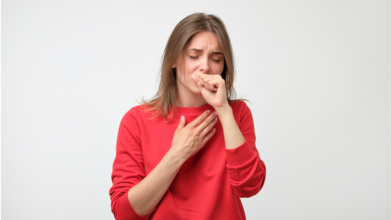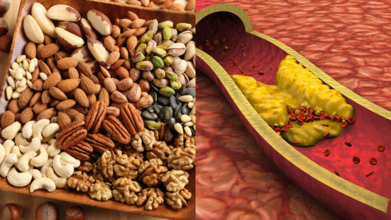- Health Conditions A-Z
- Health & Wellness
- Nutrition
- Fitness
- Health News
- Ayurveda
- Videos
- Medicine A-Z
- Parenting
- Web Stories
Can Cellphones Cause Female Infertility?

Credits: Canva
You must have come across cases and studies that talk about how cell phones damage fertility for men. But is there any evidence for female fertility? There are many contemporary health problems, from ‘text thumb’, phantom vibration and sleep disturbances to distracted driving, that are attributed to cell phones. But may they affect female fertility as well?
Fertility is recognized to be influenced by well-established factors including age, lifestyle choices, and health issues, but controversy has been prompted by worries about environmental exposures such mobile radiation. We look at the evidence here.
Can Cell Phones Harm Female Fertility
There is conflicting evidence about the relationship between mobile use and infertility issues. While research, including a 2020 review, points to possible impacts on male fertility, there isn't enough data to support comparable dangers for females.
Further research is necessary to completely determine if cell phones directly affect women's reproductive health.
The primary cause for worry is the electromagnetic field (EMF) radiation produced by smartphones. This type of radiation is released by everyday devices like computers and microwaves.
What Is EMF Radiation?
Non ionizing radiation, a low-frequency, low-energy radiation that cannot change DNA, is produced by cell phones. The Centres for Disease Control and Prevention (CDC) and the National Cancer Institute (NCI) say that this sort of radiation is unlikely to affect pregnancy or fertility.
Although some people worry that extended exposure might harm reproductive health, the available research refutes this theory. According to the NCI, there are currently no substantial dangers to a woman's fertility from cell phones.
What Does Female Fertility Actually Affect?
Among the many variables that affect fertility, using a mobile is not the most important one.
The key contributors include:
Age: As people age, the number and quality of eggs diminish, lowering their chances of pregnancy.
Weight fluctuations: Being significantly overweight or underweight might disrupt hormonal balance.
Lifestyle Factors: A poor diet, drug addiction, alcohol usage, and smoking all have a negative impact on fertility.
Hormonal Disorders: Endometriosis and polycystic ovarian syndrome are common causes of infertility.
Ovulation Issues: Infertility is connected with irregular ovulation in up to 40% of cases.
Medical Treatments: Chemotherapy and radiation may injure the ovaries.
Easy Ways to Use Cell Phones Safer
Despite the paucity of evidence against smartphones, you may reduce your exposure to electromagnetic fields (EMFs) by using these strategies:
- Avoid Carrying Cell Phones in Your Front Pockets: Avoid carrying your phone in your front pockets.
- Limit Call Duration: Use headphones or speaker mode.
- Minimise Screen Time: Keep an eye on usage and limit unnecessary browsing.
- Turn Off Devices at Night: Unplug all electronics while you're sleeping. To reduce your exposure to radiation spikes, avoid using your phone while it is charging.
Do You Need Assistance with Fertility Issues?
For assistance if you're concerned about fertility, get in touch with these reliable organisations:
- The American Society of Reproductive Medicine
- Fertility Resources from the National Infertility Association Office on Women's Health
- The American College of Gynaecologists and Obstetricians
Let's Explore
Is it possible for electronics to cause infertility?
As of now, there is no evidence that technology causes female infertility. Most household equipment emits low-level radiation, which is thought to be safe.
Do cellphones have different effects on fertility in men and women?
Research suggests a link between mobile radiation exposure and decreased male fertility; however, exposure risks to female reproductive organs are lower due to their superior insulation.
What Have We Learned?
Cellphones and other electronic devices emit low-energy electromagnetic field radiation, just like home appliances do. Even while multiple research have suggested possible reproductive impacts, particularly for males, the results for women are still unclear and conflicting.
According to the majority of scientists, mobile radiation levels are now too low to seriously impair female reproduction. Simple measures like reducing screen time and switching to hands-free devices, however, might help lessen exposure if you're still worried.
A 4-Step Science-Backed Routine That Works for Every Skin Type

There was a time when skincare felt like a competitive sport. People layered acids, scrubbed their faces raw, and measured success in stings, peels, and redness. But times are changing. A new, science-backed wave is sweeping in, one that values results without leaving your skin feeling like it has been through a survival reality show.
From Shelf Overload to Skincare Simplicity
For years, we’ve been told more is better. More products, more steps, more actives, until our bathroom shelves looked like mini-pharmacies. But skin, much like us, thrives in balance. Aggressive routines may deliver quick wins, but they often come with side effects like irritation, dryness, or breakouts that weren’t invited to the party.The modern approach is a gentler, more measured one: using well-formulated products that are kind to the skin barrier but still pack enough punch to make a visible difference. And the best part? You only need a few steps, not a 12-item shopping list.
The Four Steps That Actually Work
Malini Adapureddy, Founder of Deconstruct Skincare, swears by a routine that’s simple enough to remember before coffee and effective enough to see results in weeks. Designed for Indian skin and climate, this four-step method covers the essentials: cleansing, treating, moisturising, and protecting.
Step 1: The Clean Slate
Every story starts somewhere, and for your skin, that’s cleansing. But the goal isn’t to strip your face like it’s a frying pan that’s just seen a masala spill. A gentle oil-control face wash with salicylic acid and niacinamide is the ticket. Salicylic acid slips into pores to keep them clear, while niacinamide calms and balances.Step 2: The Targeted Glow Shot
Once the canvas is prepped, it’s time for the serum stage. Enter a 10% vitamin C serum with 0.5% ferulic acid. Vitamin C is your radiance best friend, helping to fade pigmentation and even out skin tone, while ferulic acid boosts its stability and antioxidant power. Together, they help defend against environmental stressors and bring your complexion back from the land of dull.Unlike some actives that feel like they’re burning through your soul, this combination is gentle enough for daily use.
Step 3: The Barrier Hug
Moisturiser is often seen as the “optional” step, especially if you have oily skin. But hydration isn’t just about adding water; it’s about locking it in. A lightweight, oil-free moisturiser with natural moisturising factors (NMF) and panthenol keeps your skin barrier happy. It helps reduce sensitivity, supports repair, and works in harmony with your actives. And in India’s hot, humid, sometimes dusty climate, that’s a much-needed shield.Step 4: The Non-Negotiable
Sunscreen. Always sunscreen. Whether you’re outside chasing errands or inside chasing deadlines, UV damage is sneaky. It causes pigmentation, speeds up ageing, and undoes all the hard work your serum and moisturiser put in. A broad-spectrum, gel-based sunscreen keeps things light, non-greasy, and comfortable, even under makeup.Why Gentle Works Better Than You Think
There’s a myth that 'strong' means 'effective'. In reality, harsh products can damage your skin barrier, leaving it inflamed and reactive. Gentle formulations, when done right, work gradually but deeply. They’re like the friend who doesn’t shout advice but still changes your life.Consistency is the secret here. When your skin isn’t constantly fighting irritation, it can focus on repairing itself, building resilience, and looking better over time.
What Is Pulmonary Fibrosis and Why That Annoying Cough Might Be More Than Just a Cold

Credits: Canva
If you’ve been coughing for weeks, blaming it on “lingering winter sniffles” or chalking it up to “just getting older,” it might be time to step away from the cough syrup and lean in for some uncomfortable truth. Your cough could be more than a seasonal annoyance. In rare but serious cases, it could be a red flag for a life-limiting condition called pulmonary fibrosis.
What is Pulmonary Fibrosis?
In plain terms, “pulmonary” means lungs, and “fibrosis” means scarring. It’s a serious, progressive condition where lung tissue becomes scarred and stiff, making it increasingly hard to breathe.
Reportedly, there’s currently no cure. Treatments exist, but they mainly slow down the damage rather than reverse it. The sooner you get diagnosed, the better your chances of managing symptoms and that’s where spotting the signs early is crucial.
Symptoms to Watch For
- Shortness of breath (especially when climbing stairs or speed-walking to catch the bus)
Why That Cough Happens
Coughing is your body’s bouncer, booting out anything that might harm your lungs — dust, smoke, rogue crumbs, the works. The process involves your vocal cords clamping shut, then snapping open with a burst of air.
With pulmonary fibrosis, this reflex can get stuck on a loop. Coughing irritates the vocal cords, which makes you cough more, which irritates them further, a vicious cycle that can turn even a quiet cup of tea into a coughing fit.
The Four Flavours of Cough
- Acute cough – Lasts less than three weeks; often tied to infections or irritants.
Coughs can also be:
- Dry/unproductive – Triggered by things like temperature changes, dusty air, or laughing.
Who’s More at Risk?
While pulmonary fibrosis can happen to anyone, your risk might be higher if you:
- Are over 50
Managing the Cough
A pulmonary fibrosis cough often doesn’t respond to standard cough medicines. Instead, treatment usually focuses on easing symptoms and improving quality of life.
Your doc may recommend alternative medications used for chronic cough in other conditions. These don’t cure the scarring but can make the coughing less intrusive. They’ll also want to check for other contributing factors like acid reflux, sinus issues, or side effects from medication, because if those are making things worse, tackling them can help.
Everyday Coping Tricks
While you work with your doctor, you can try a few lifestyle tweaks to manage coughing fits:
- Avoid smoky, dusty, or heavily polluted spaces
Pulmonary fibrosis is rare, but catching it early can mean more treatment options and better management. Plus, you’ll finally know whether your cough is from a stubborn cold or something that needs closer attention. Your cough could be a harmless side effect of a dusty ceiling fan or it could be your body waving a red flag.
Scientist Reveals the Tiny Foods That Can Transform Your Cholesterol in Just 10 Days

If you’ve ever stared at a packet of mixed nuts wondering whether to sprinkle them over your porridge or just eat them by the handful, here’s your permission slip: go for it. According to Dr Sarah Berry, a professor at King’s College London and Chief Scientist at ZOE, nuts and seeds are not just snackable; they are good for cholesterol crunching. In fact, swap some of your less healthy fats for these nutritional powerhouses, and you could lower your cholesterol by up to 10 per cent in just 10 days. That is faster than most fad diets.
The 10-Day Cholesterol Challenge
High cholesterol often feels like one of those invisible problems, until it suddenly is not. It can quietly build up in your arteries, increasing the risk of heart attacks and strokes. But Dr Berry, during an appearance on the Zoe podcast, said that you can make a real difference in under two weeks by tweaking, not overhauling, your diet. It’s not about eating less fat; it’s about eating the right kind of fat.
And this is where most people get it wrong. “Don’t do a low-fat diet,” Dr Berry warns, calling the idea “radical” to anyone still following decades-old advice. Instead, aim for a moderate-fat diet rich in polyunsaturated and monounsaturated fats—exactly the kinds you’ll find in nuts, seeds, and certain oils.
Why Low-Fat Diets Miss the Point
It is tempting to think cutting fat will cut cholesterol, but Dr Berry explains that’s a trap. Not all fats are bad. Saturated fats, found in red meat and some processed foods, can push LDL cholesterol—often dubbed “bad” cholesterol—into dangerous territory. But polyunsaturated fats, abundant in seeds, seed oils, and many nuts, do the opposite.
Simply adding nuts to your meals, whether as a snack, salad topping, or nut butter, can slash LDL cholesterol by 5 to 10 per cent. You have to make a swap. This benefit comes from replacing “harmful” fats, like those in certain animal products and fried foods, with healthier plant-based fats.
Seeds: The Cholesterol Fighters
Sunflower seeds, flaxseeds, chia seeds—they’re all loaded with polyunsaturated fatty acids that support heart health. Stir them into yoghurt, blend them into smoothies, or scatter them over roasted veggies. You’ll barely notice the extra effort, but your arteries will thank you.
Seed oils, like sunflower and flaxseed oil, can also be smart choices in moderation, adding healthy fats to your cooking without the cholesterol-raising impact of certain animal fats.
Rethinking Dairy, Meat, and Carbs
Dr Berry isn’t out to demonise all animal products. Fermented dairy like yoghurt and cheese gets a surprising green light. These foods, she says, don’t have the cholesterol-raising effect you might expect from their saturated fat content. That’s not permission to live on brie and cheddar, but it is a reason to stop fearing your cheese board.
Red meat, however, is a different story. Packed with saturated fats, it’s a direct contributor to rising cholesterol levels. Swapping steak nights for lentil stews or chickpea curries a couple of times a week could make a noticeable difference to your numbers.
Then there’s the carbohydrate conundrum. The real trouble lies with refined carbs like white bread, white rice, and sugary snacks. These are rapidly processed by your body and can be converted into triglycerides, which worsen cholesterol profiles. But whole grains are firmly in the “good for you” column. Wholegrain bread, brown rice, oats, and quinoa can help improve cholesterol levels when they replace the refined stuff.
Building Your 10-Day Cholesterol Menu
Swap your morning white toast for porridge topped with walnuts and chia seeds. Your mid-morning biscuit could become a small handful of almonds. At lunch, toss sunflower seeds into your salad, and use olive or sunflower oil for dressing. Dinner might feature grilled salmon or chickpeas instead of steak, with a side of quinoa instead of white rice.
Why This Works So Fast
Cholesterol levels can be surprisingly responsive to dietary changes. LDL cholesterol particles are constantly being produced and cleared from your bloodstream. When you replace saturated fats with healthier fats, you improve your body’s ability to remove LDL cholesterol. Combine that with reducing refined carbs and upping your wholegrain intake, and the improvement can be measurable in just days.
Dr Berry’s advice is refreshingly realistic: no calorie counting, no extreme restrictions, just sensible swaps. It’s about building habits you can maintain beyond the initial 10 days, keeping your cholesterol low for the long haul.
Forget the idea that lowering cholesterol means bland food and joyless salads. With nuts, seeds, and the right fats, you can eat deliciously and still give your heart a health boost in record time.
© 2024 Bennett, Coleman & Company Limited

